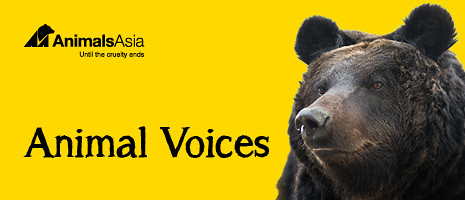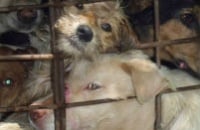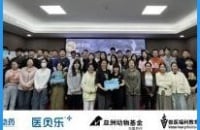How art can help us imagine a cruelty free world
26 August 2015

From Banksy to the creators of internet cat memes - the people who will shape a cruelty-free world are the people who can best imagine it. Carolyn Merino Mullin explains.
It’s no accident that when we imagine a world or an environment that is a significant improvement on what we have now, we call it our “vision”.
When it comes to animal welfare, we owe it to ourselves, and the animals whose rights we champion, to use the most powerful medium we can to address animal issues. And there’s no denying that we live in an age where the power of the image is unparalleled.
As targets of endless advertisements, social media channels, and documentaries, we’re deluged by pictorial information. We communicate and stay connected in this manner too, be it through Skype chats, emoticons or Facebook memes. If anyone can think of a better, more powerful medium than the visual to address animal issues, I’m all ears.

Take videos of cats as a point of departure - our feline friends have never seen such massive amounts of attention as they do today, thanks to the internet and the proliferation of cat videos available. I’d like to think that the Walker Art Centre had a little something to do with it, when they decided some years ago to stage “The Internet Cat Video Film Festival”. Several critics lambasted this prominent arts institution for hosting something so ordinary, so far removed from what was considered “artsy”. But it seems to me that if one calls it art, it is art. Now cats rule the internet, as do a proliferation of dog and cat rescues across the world.
I like to call this manner of using the image to get your message across, “art as activism”. In some ways, I am the least qualified to be talking about art as activism. I didn’t study art criticism or history or pursue a fine arts degree. My better half, a seasoned artist, accompanies me to art openings, yet I am often left feeling bemused by contemporary artwork and conceptual installations. I’ve often wished a local college would offer a class in visual literacy for us lay folk!
In spite of this, I have a firmly grounded belief that there is inherent value and incredible power in the arts, and that our animal protection movement must embrace, celebrate and provide additional platforms for artists to do what they do best.
We know that visual imagery is critically important. But with so much content vying for our attention, it’s also quite easy to get lost in the visual shuffle. The arts are a way for us to set our movement, our message, and the animals we advocate for, apart.

One of the leaders in this effort is Louie Psihoyos, the director behind hard-hitting documentaries The Cove and Racing Extinction. In the latter Psihoyos audaciously lights up the New York City skyline with animated infographics depicting just how quickly we’re losing our wildlife in the current period of our evolution. But while his project took an entire group of talented creative professionals to put together, even just one person can make a tremendous difference.
At the National Museum of Animals and Society based in Los Angeles - the first animal protection museum anywhere - our job is to preserve our movement’s living history. We more broadly explore the roles animals play in society and culture and nurture current and future generations of animal lovers through humane education programming.
One of the things we’ve come to learn is that artists have a long history of educating the public on animal issues through their creative talents. One of my favourites is English cartoonist and diehard animal lover William Hogarth (1697 – 1764). Understanding that many of his fellow citizens were illiterate, Hogarth harnessed the power of the visual to change society’s perceptions and actions.

The Four Stages of Cruelty was a series of prints which were made for little cost and distributed to the masses. In them, Hogarth depicted common scenes of animal cruelty and insinuated that animal tormentors will face an ill fate if they continue with their actions. The protagonist, Tom Nero, is not only an animal abuser, but a murderer who is ultimately executed and his body dissected – a very visceral and effective means of communicating a message of compassion to the masses, at least in the eighteenth century.
On a slightly lighter note, we have a number of vintage “Be Kind to Animals” posters in our museum collection. These were created by some of the leading artists in America for groups like the American Humane Education Society and their Bands of Mercy, a humane youth organisation with over 70,000 local groups across the USA. These were simple yet effective tools to communicate kindness in classrooms, churches, and community centres.

If only we were still living in those simpler days! Now we have phantom artists like Banksy whose work provokes scorn and praise in equal measure - but always a conversation. His ‘Siren of the Lambs’ truck in New York City shone an artistic spotlight on the subject of factory farming and to a whole new demographic; art aficionados.
The playwright Luis Valdez once said: “To whom does the future belong? It belongs to those who can imagine it.” If we truly want a just, kind and peaceful world, artists – those with the mindset to conceive and the determination to create – must be along for the ride.
Carolyn Merino Mullin is the founder and director of the National Museum of Animals and Society (NMAS) in Los Angeles, the first museum of its kind dedicated to enriching the lives of animals and people. Carolyn was previously the director for Casa Dolores, a Mexican folk art museum in Santa Barbara, California, and a smattering of animal not-for-profit organisations and museums. Her writings have been featured in “VegNews”, “Defiant Daughters: 21 Women on Art, Activism, Animals, and The Sexual Politics of Meat”, and the upcoming anthology, “Mourning Animals”. The newly published book “The Art of the Animal” features an essay by Carolyn and serves as the catalog for an exhibition at NMAS. Learn more about Carolyn and the museum at www.museumofanimals.org.
BACK





 5 reasons the dog meat trade must end
5 reasons the dog meat trade must end
 New year, new home for Christmas the Bear!
New year, new home for Christmas the Bear!
 Veterinary welfare training – pain management
Veterinary welfare training – pain management